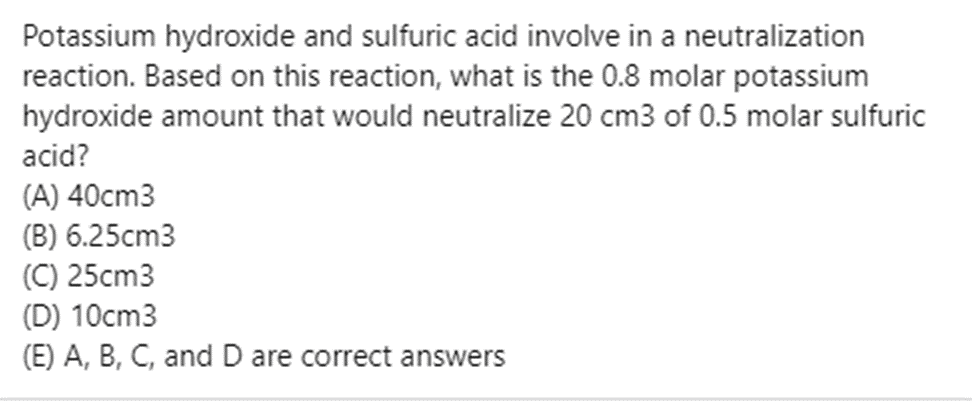The Reaction between Potassium Hydroxide and Sulfuric acid
Answer the question in Figure 1.
First, students must write a balanced chemical equation between sulfuric and potassium hydroxide to answer this question. Potassium hydroxide is a base, and when a base reacts with an acid, salt, and water is produced. Therefore, the general equation of the reaction between sulfuric acid and the base becomes:
Base + Acid Salt +
water
Equation 1
 |
| Figure 2: A conical flask for titrations |
Now, by inserting
potassium hydroxide and sulfuric acid in Equation 1, the equation leads to
Equation 2.
KOH (aq) + H2SO4 (aq)
K2SO4 (aq) + H2O (l)
Equation 2 (Unbalanced equation)
On the left side of
Equation 2 are one mole of potassium, three moles of hydrogen, one mole of
sulfur, and five moles of oxygen in reactants. On the right hand of the same
equation are two moles of potassium, one mole of sulfur, five moles of oxygen,
and two moles of hydrogen on the product side. For this reason, Equation 2 is
not balanced. The number of potassium and hydrogen moles is not the same on
both sides. Therefore, they must be balanced by introducing appropriate
numbers, which results in Equation 3.
2KOH (aq) + H2SO4
(aq) K2SO4 (aq) + 2H2O (l)
Equation 3
Introducing
stoichiometric coefficients two before potassium hydroxide on the left-hand
side and two before water balances the equation. Based on the equation, 2:1 is
the mole ratio between the potassium hydroxide and sulfuric acid, which is now
applied to the volumetric analysis.
The variables (n, c,
V) are used in volumetric analysis. n denotes the number of moles, c is the
concentration(mol/L or mol/dm3), and V is the volume(dm3 or mL).Now, by using
the relationship concentration(mol/L) and volume(Ml) in the dilution
formula(M1V1=M2V2), the required volume can be determined.
In the dilution
calculation formula, M1 (in molar) and V1 (mL) are the
concentration of potassium hydroxide. On the other hand, M2 (in
molar) and V2 (mL) are the concentration and volume of sulfuric
acid. Furthermore, 2 moles of potassium hydroxide require one mole of sulfuric
acid to form the product. Hence, to obtain 20cm3 of 0.5M of
sulfuric, we must multiply the sulfuric acid by two (the stoichiometric
coefficient). Potassium hydroxide is an excess reactant, while sulfuric is a
limiting reactant.
(0.8M*V1) =2(0.5M*20cm3)
V1=
(2(0.5M*20cm3))/0.8M
V1= 25cm3




Comments
Post a Comment